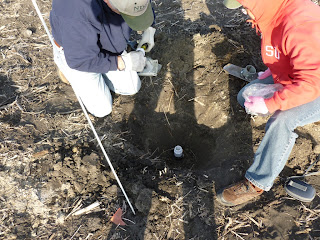Thus far our major field activities have included:
1) The setup and installation of our Eddy Covariance system in a NEW location at the research site because the farmer is now irrigating the center of the field and using control drainage on the southern portion.
2)The setup of all three wireless weather stations located in the undrained (UD), free drained (FD), and subirrigated (SI) fields.
This is a picture of the SI wireless weather station with Eddy Covariance in the background. On this weather station there is a photosynthetically active radiation, rain, soil moisture/temperature, and relative humidity/temperature sensor. The other two wireless weather stations in the UD and FD fields have similar sensors with the addition of wind sensors which measure wind gust, direction, and speed. In this picture the relative humidity and temperature sensor is being lowered to 1.0-1.5m above the crop canopy. 3)The lowering and raising of the 24 piezometers (screened wells) located through out the research site due to the farmer tilling and planting his field. The wells must be lowered a foot or more beneath the ground surface so that the farmer does not damage the equipment while he tills and plants the field. Then once the field is tilled and planted we can raise the piezometers and launch the HOBO water level transducers, placed inside the wells, which help us monitor the ground water level throughout the field.
4)Installation of turbidity and water level sensors at two locations in the county drainage ditch. One set is located kitty corner of the FD field and the other is located at the north western point of the SI and CD field. By doing this we are able to monitor water quality in the ditch before and soon after subsurface drainage has entered.
Sadly, however, due to a fair amount of rain over the past couple of weeks the water level in the ditch raised above the sensors and either destroyed or damaged most of the sensors and data loggers. They are in the process of being repaired or replaced, and are expected to be back up and running within the next week or so.
5)Installation of a Stingray Ultra Sonic Flow Meter, which monitors water level, velocity, and temperature of flow in a pipe or channel. This sensor is located in the Free Drainage (FD) tile outlet, and will allow us to quantify the volume and timing of drainage events from the FD field.
6)Installation of weirs and water level sensors at drainage outlets for the CD, SI, and FD fields. Again, we hope to estimate the surface runoff from these fields by making use of v-notch weirs and HOBO transducers, which monitor water level every 10 minutes.
This has been an exciting and BUSY spring, but now it's time to get to the fun part and put our sensors/equipment to work as the growing season begins!











No comments:
Post a Comment